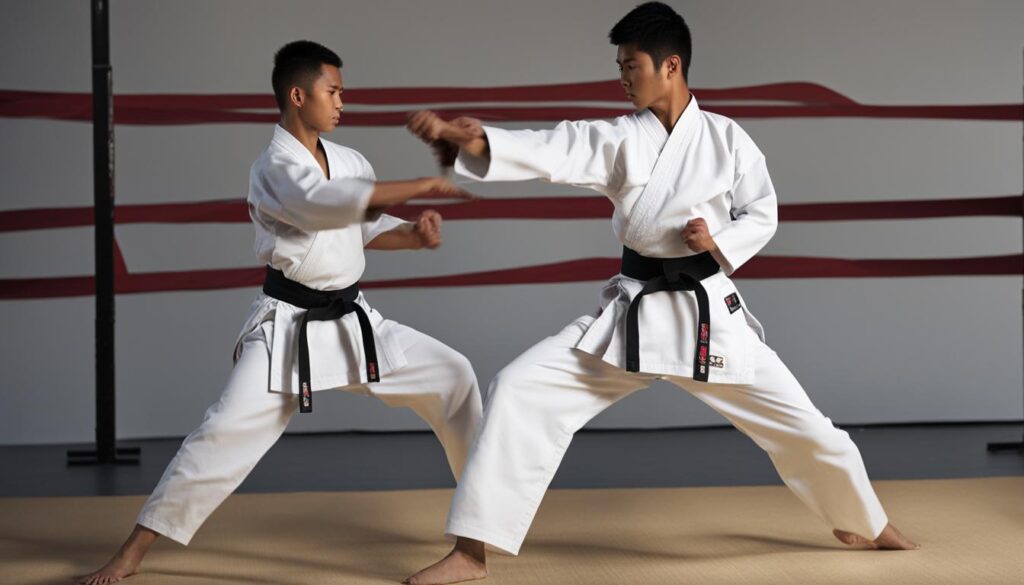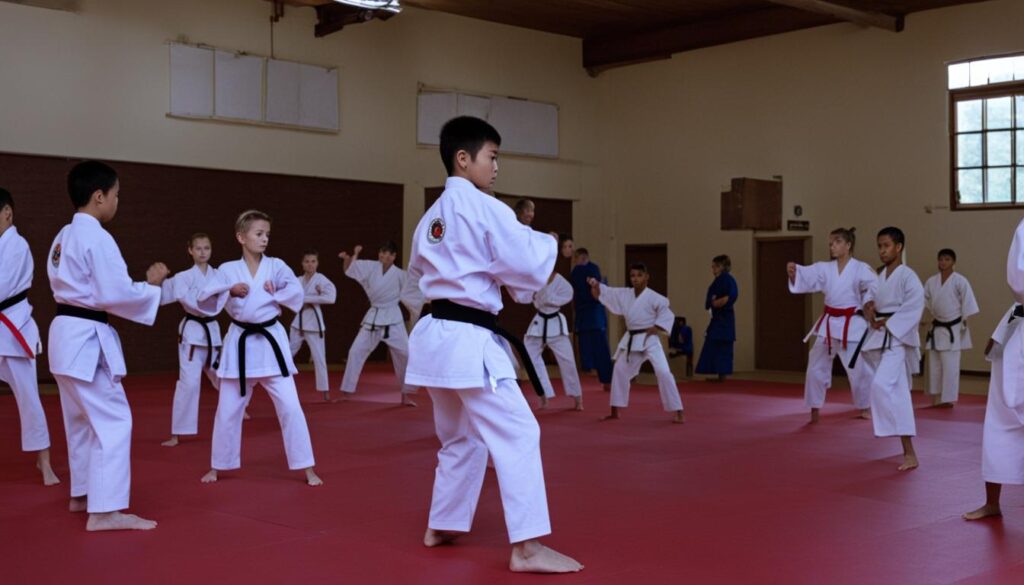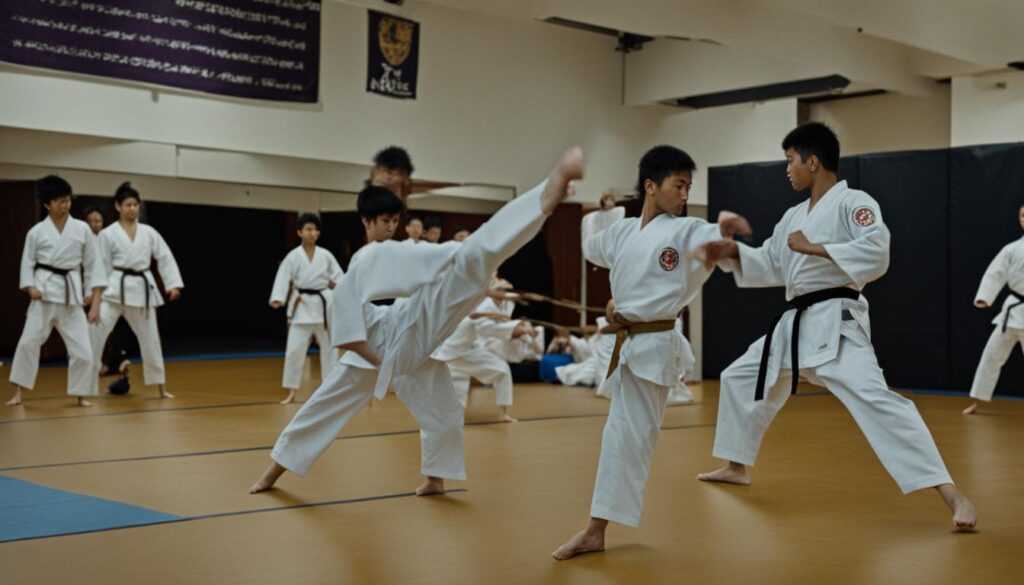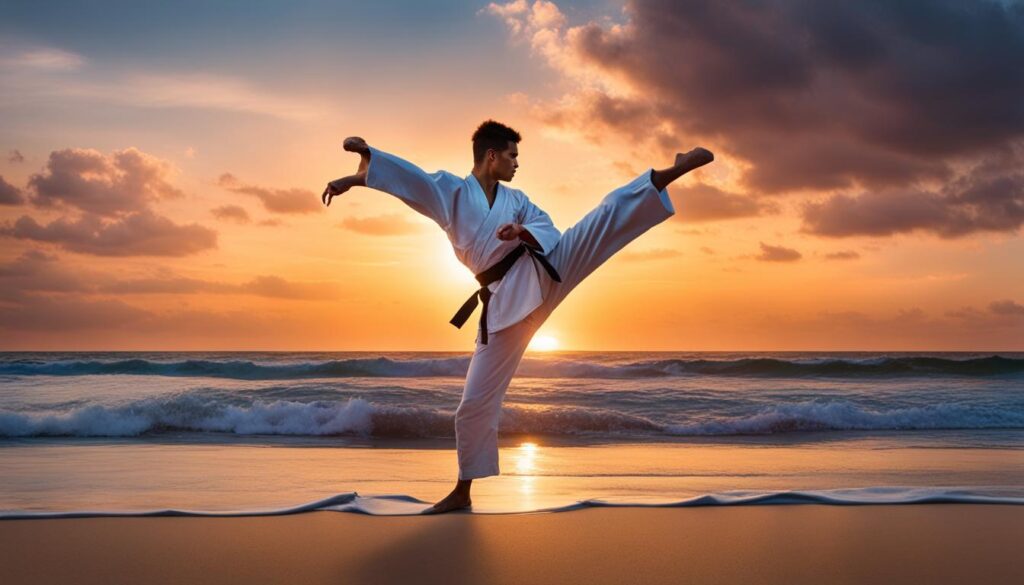Welcome to our beginner’s guide on mastering the art of karate! Whether you’re a complete novice or have some experience, this guide will provide you with valuable insights and techniques to accelerate your learning journey. Karate is a discipline that combines physical strength, mental focus, and self-defense techniques. In this guide, we will explore the various aspects of learning karate and share tips on how to progress quickly.
Key Takeaways:
- Clear your mind and enhance focus through meditation
- Warm up your muscles and stretch to prevent injuries
- Understand the philosophy of karate, emphasizing peace and conflict resolution
Getting Started: Preparation and Basics
Before embarking on your karate journey, it’s essential to lay a strong foundation. Here are some key tips to help you get started on the right foot.
Research and Find a Reputable Karate School
Begin your karate learning experience by researching and identifying a reputable karate school in your area. Look for schools that have experienced and qualified instructors, a positive learning environment, and a focus on safety.
Investing time in finding the right karate school ensures that you receive proper guidance and quality instruction throughout your karate training journey.
Attend a Trial Class
Once you’ve identified a potential karate school, attending a trial class is a great way to gauge the teaching style, atmosphere, and overall suitability of the school. During the trial class, you’ll have the opportunity to observe the instructor’s teaching methods and interact with fellow students.
This firsthand experience will help you make an informed decision about whether the karate school aligns with your learning preferences and expectations.
Invest in Karate Gear
As you commit to learning karate, it’s important to invest in the necessary gear. Karate gear typically includes a karate uniform (gi) and accompanying belt. Wearing the appropriate uniform not only fosters a sense of discipline and camaraderie but also ensures safety during training sessions.
Additionally, it’s advisable to invest in protective equipment such as hand wraps, shin guards, and mouthguards as your training progresses and intensifies.
Regularly Attend Classes and Practice Outside of Class
Consistency is key to developing your karate skills. Attend classes regularly to benefit from the guidance and expertise of your instructors. Practice outside of class is equally crucial to reinforce what you learn and improve your technique.
Set aside dedicated time for individual training sessions at home or in a suitable practice area. This extra effort will help you refine your karate techniques and progress more effectively.
Set Goals for Yourself
Setting clear and achievable goals is essential for tracking your progress in karate. Whether you aim to earn a higher belt rank or master specific techniques, having goals helps motivate you and provides direction for your training.
Discuss your goals with your instructor, who can provide guidance and support to help you reach those milestones. Regularly reassess and adjust your goals as you grow in skill and confidence.
Karate Training Tips
Here are a few additional tips to enhance your karate training experience:
- Stay hydrated: Drink plenty of water before, during, and after training to stay hydrated and maintain optimum performance.
- Warm-up and stretch: Prior to each training session, perform a warm-up routine to increase blood flow and prepare your muscles. Follow it up with stretching exercises to enhance flexibility and reduce the risk of injury.
- Listen to your body: Pay attention to any discomfort or pain during training and notify your instructor if necessary. Rest and recover when needed to prevent overexertion and injuries.
- Embrace a growth mindset: Karate is a journey of continuous learning and improvement. Embrace challenges, learn from mistakes, and persevere. With dedication and a positive mindset, you’ll achieve your goals.
By following these guidelines and training consistently, you’ll be well on your way to mastering the art of karate.
Mastering the Stances
When it comes to mastering karate techniques, learning the correct stances is vital. Karate stances provide the foundation for powerful and effective movements, ensuring stability, balance, and control. In this section, we will explore three common stances that are utilized in various types of karate: the natural stance, the front stance, and the cat stance.
The Natural Stance
The natural stance is the starting position in karate. Stand with your feet shoulder-width apart and parallel to each other. Keep your knees slightly bent and maintain a relaxed posture. This stance allows for quick and fluid movements, enabling you to respond swiftly to any situation.
The Front Stance
The front stance, also known as zenkutsu dachi, is the most fundamental stance in karate. Step forward with one foot, keeping your feet hip-width apart. The front foot should be pointing forward, while the back foot is turned at a 45-degree angle. Distribute your weight evenly between the front and back leg, maintaining a strong and grounded position. The front stance provides stability and power, allowing you to execute strikes with maximum force.
The Cat Stance
The cat stance, or nekoashi dachi, is a versatile stance that emphasizes agility and quickness. Begin by standing with your feet together. Step one foot back, placing it behind the lead foot with the heel raised. The majority of your weight should be on the front leg, while the back leg remains light and ready to react. The cat stance is particularly useful for evasion and counterattacking, making it a valuable technique in self-defense scenarios.
By mastering these stances, you will lay a solid foundation for your karate practice. They are the building blocks that enable the execution of various techniques and movements. Now that you understand the importance of stances in karate, let’s delve deeper into the forms and techniques that rely on these stances.

Perfecting Your Punches and Blocks
Mastering punches and blocks is fundamental in karate. By honing your skills in these techniques, you’ll be better equipped to defend yourself in various situations and enhance your overall karate performance. Whether you are a beginner or have previous experience, perfecting your punches and blocks is crucial for self-defense with karate.
- Straight punch: A powerful and direct punch aimed at your opponent.
- Upper-cut: An upward punch targeting the chin or body’s midsection.
- Knife-hand strike: Striking with the edge of your hand, often used to target pressure points.
- Spear-hand strike: A focused strike resembling a spear’s tip, targeting vulnerable areas.
- Elbow strike: Utilizing the strength of your elbow for close-range attacks.
- Backfist: Striking with the back of your hand, delivering a swift blow.
Practice these techniques with proper form and body alignment, focusing on power, accuracy, and speed. Regularly incorporating punches into your training routine will help you develop strength in your upper body and improve your coordination.
Effective blocking techniques are equally important in karate. They allow you to defend against incoming attacks and create opportunities for counter strikes. When practicing blocks, concentrate on:
- Timing: Blocking at the right moment to intercept the opponent’s strike.
- Placement: Positioning your arms and hands to protect vulnerable areas of your body.
- Stability: Maintaining a solid foundation to absorb and redirect the force of the attack.
By mastering both punches and blocks, you’ll have a well-rounded skill set for self-defense and a better understanding of karate’s principles. Remember to practice regularly and seek guidance from experienced instructors to ensure proper technique and continuous improvement.
Dynamic Kicks in Karate
Kicks are an essential part of karate, offering power and versatility in self-defense techniques. Mastering various kicks can take your karate skills to the next level, whether you are a kid learning karate or an advanced practitioner seeking further training. By focusing on precision, power, and speed, you can develop dynamic kicks that strengthen your legs and enhance your flexibility.
Here are some of the kicks you should aim to master:
| Kick | Description |
|---|---|
| Front Snap Kick | A straight kick delivered with the ball of the foot, targeting the opponent’s midsection |
| Side Snap Kick | A quick and powerful kick delivered with the side of the foot, aimed at the opponent’s ribs or legs |
| Side Trust Kick | A strong thrusting kick executed sideways towards the opponent, engaging the hips and core muscles for maximum impact |
| Back Trust Kick | A reverse thrusting kick delivered with the heel towards the opponent’s midsection, utilizing hip rotation and body mechanics |
| Round Kick | A circular kick targeting the opponent’s head or torso, performed with the shin or instep |
Remember, practice is key to perfecting these kicks. Start with slow and controlled movements, focusing on technique and form. Gradually increase speed and power as you gain confidence and strength. Incorporate these kicks into your regular training sessions to improve your overall karate skills.
By mastering dynamic kicks, you can enhance your self-defense abilities and excel in karate.
Sparring and Testing Your Skills
Once you have learned the fundamental techniques of karate through your beginner classes or online lessons, it’s time to put them to the test. Sparring is a crucial component of karate training, as it allows you to apply your skills in a controlled environment.
To start sparring, find a training partner who is at a similar skill level. Together, you can practice different techniques, combinations, and defensive maneuvers. This hands-on experience will help you develop your timing, speed, and accuracy.
During sparring sessions, you will have the opportunity to test your skills and stamina. It’s an excellent way to see how well you can execute your techniques under pressure. Remember to always maintain control and focus on technique rather than brute force.

As you progress in your karate journey, you will have the chance to advance through belt testing. Belt testing evaluates your proficiency in various techniques and showcases your growth as a karate practitioner. It’s a rewarding experience that validates your hard work and dedication.
Sparring sessions and belt testing are typically conducted in a traditional karate dojo, but you can also find online platforms that offer virtual sparring and testing. These online karate lessons provide a convenient way to continue your training from the comfort of your own home.
Remember, sparring is not about winning or losing. It’s about improving your skills, learning from each interaction, and gaining the confidence to handle real-life situations. Embrace the challenge and enjoy the opportunity to test your abilities in a supportive environment.
Developing Kata Proficiency
In the world of karate, kata holds immense importance as it is the core practice that develops one’s skills and understanding of the art. Kata are pre-arranged sequences of movements that embody various self-defense techniques and enhance focus and precision. By practicing different kata, individuals refine their technique and deepen their comprehension of karate forms and techniques.
When starting your journey with kata, it’s best to begin with lower-level forms and gradually progress to more complex combinations. Each kata has its own distinct set of movements and techniques, allowing practitioners to learn and master a wide range of skills. Through dedicated practice, kata proficiency is developed, equipping individuals with a solid foundation in karate.
“The kata is not a demonstration; it is a test of your understanding.”
Regular and consistent practice of kata helps cultivate body awareness and coordination. It encourages proper breathing techniques and teaches restraint and control in executing techniques. Each movement within a kata has a specific purpose, which contributes to the overall flow and effectiveness of the sequence.
By immersing oneself in the practice of kata, individuals gain a deep understanding of the principles and philosophy behind karate. The repetitive nature of practicing kata allows practitioners to internalize the techniques and movements, enabling them to react instinctively in real-life situations.
Furthermore, kata training provides an opportunity for self-reflection and self-improvement. Practitioners can assess their own technique, timing, and focus, identifying areas for growth and refinement. As they progress through different levels of kata, individuals will discover new challenges and ways to enhance their performance.
| Kata Name | Description |
|---|---|
| Heian Shodan | Introductory kata that builds a strong foundation in basic techniques and stances. |
| Tekki Shodan | Focused on close-quarters combat and the development of inner strength and power. |
| Bassai Dai | Emphasizes strong and powerful movements, showcasing the application of technique under pressure. |
| Empi | Known for its quick and explosive movements, teaching effective hand strikes and footwork. |
It is important to note that kata training should not be treated as mere choreography or memorization; it is a continuous process of refinement and self-improvement. By devoting oneself to the art of kata, individuals can unlock the true essence of karate and develop a profound connection between mind, body, and spirit.
Continuing Your Journey in Karate
Karate is not just a martial art; it is a lifelong journey of self-improvement and personal growth. As you progress in your karate training, it is essential to keep refining your skills and expanding your knowledge.
Here are some valuable karate learning techniques and training tips to help you continue on your path:
1. Continuous Practice
Consistency is key in karate. Make it a habit to practice regularly to maintain and improve your skills. Set aside dedicated time each day for training and focus on specific techniques or drills that you want to develop.
Remember, practice makes perfect, and repetition is crucial for muscle memory and mastering karate techniques.
2. Embrace Discipline and Respect
Discipline and respect are fundamental principles in karate. Embrace the discipline required to follow the rules and etiquette of the martial art. Respect your instructors, fellow students, and the dojo environment.
By embodying these principles, you not only become a better karateka but also cultivate important life skills that extend beyond the dojo.
3. Seek Guidance from Experienced Instructors
Continually seek guidance from experienced karate instructors who can provide valuable insights and mentorship. Their expertise and knowledge will help you refine your techniques, deepen your understanding of karate, and overcome any training hurdles.
Consider joining organized training programs, attending seminars, or seeking one-on-one coaching to enhance your karate journey.
4. Explore Cross-Training Opportunities
Expand your horizons by exploring cross-training opportunities in other martial arts or fitness disciplines. Cross-training can provide a fresh perspective, enhance your overall physical abilities, and complement your karate training.

5. Set New Goals
Continually set new goals for yourself to maintain motivation and track your progress. Whether it’s advancing to the next belt level, competing in tournaments, or mastering a challenging technique, having goals gives you direction and a sense of achievement.
Consult with your instructor to set realistic and attainable goals that align with your abilities and aspirations.
Remember, learning karate is a journey, not a destination. Embrace each step along the way, stay dedicated to your training, and enjoy the transformation and growth that karate brings to your life.
Karate Beyond the Dojo
Karate is not just a physical activity; it is a philosophy and a way of life. The principles of discipline, respect, and humility that you learn through karate can be applied to your everyday life, making you a better person both on and off the mat.
One way to carry the spirit of karate beyond the dojo is by helping others and giving back to the community. Whether it’s volunteering at a local shelter, organizing a charity event, or simply lending a helping hand to those in need, your actions can make a positive impact in the lives of others.
Another way to continue your journey in karate is by teaching martial arts. By sharing your knowledge and skills with others, you not only help them develop self-defense abilities but also instill the values of discipline, respect, and perseverance in their lives. Teaching karate can be a fulfilling way to make a difference and contribute to making the world a better place.
As you progress in your karate training, consider exploring advanced karate techniques and training methods. Advanced karate training can challenge you both physically and mentally, pushing you to new limits and helping you reach your full potential. Seek guidance from experienced instructors who can provide you with personalized training plans and techniques to take your karate skills to the next level.

Remember, karate is not just about self-defense; it is about personal growth, self-improvement, and making a positive impact in the world. Embrace the principles of karate in everything you do, and let the spirit of karate guide you to become the best version of yourself.
Choosing the Right Karate Training Program
When embarking on your karate journey, selecting the right training program is crucial for your learning and growth. Consider several factors to ensure you find the best fit for your needs, whether you are a beginner or looking for online options.
Start by researching the reputation of the instructor and school. Look for experienced instructors who have a strong background in karate and are passionate about teaching. A reputable school with a positive community and a focus on discipline and respect will provide a supportive learning environment.
Another important aspect to consider is the teaching style. Some programs may have a more traditional approach, while others may incorporate modern teaching methods. Evaluate your learning preferences and find a program that aligns with your goals and preferences.
Additionally, examine the curriculum offered by different training programs. A well-rounded curriculum should cover elements such as stances, punches, kicks, self-defense techniques, sparring, and kata. Ensure that the program provides a balanced mix of theoretical knowledge and practical application to help you develop a solid foundation in karate.
Attending trial classes is an excellent way to gauge if a karate training program is right for you. Many schools offer trial classes or introductory packages for beginners. Use this opportunity to experience the teaching style, interact with instructors, and assess the overall atmosphere of the school.
For those seeking flexibility and convenience, online karate lessons can be a great option. With online classes, you can learn karate at your own pace and schedule. Make sure to research the credibility and reputation of online platforms and instructors before committing to a program.
Remember, choosing the right karate training program will not only make your learning experience enjoyable but also contribute to your progress and development as a martial artist. Take your time to evaluate different options and find a program that aligns with your aspirations and goals.
| Instructor and School Reputation | Teaching Style | Curriculum | Trial Classes | Online Karate Lessons |
|---|---|---|---|---|
| Research the reputation of the instructor and school to ensure they have experience, a strong background in karate, and a positive learning environment. | Consider the teaching style of the program, whether it’s traditional or modern, and determine which suits your learning preferences. | Evaluate the curriculum offered by different programs, ensuring it covers various aspects of karate training, from stances to self-defense techniques. | Participate in trial classes to experience the teaching style, interact with instructors, and assess the overall atmosphere of the school. | If seeking flexibility and convenience, explore online karate lesson options, ensuring the credibility and reputation of the platform and instructor. |
Conclusion
Learning karate is a journey that requires dedication, practice, and discipline. By following the steps outlined in this guide and embracing the principles of karate, you can unlock the path to self-improvement and mastery of this dynamic martial art. Remember to approach your karate training with respect for your instructors, fellow students, and the philosophy behind karate.
As you embark on your karate journey, always prioritize consistency in your practice. Regular training sessions and consistent effort will help you build a strong foundation and improve your skills over time. Set specific goals for yourself to stay motivated and track your progress. Celebrate your achievements along the way, no matter how small they may seem.
Additionally, remember to always prioritize your safety during your karate training. Warm up before each session to prepare your muscles and joints, and listen to your body to avoid overexertion. Technique is key, so focus on mastering the fundamentals and maintaining proper form in every movement.
Finally, karate is not just about physical strength and techniques; it is also about mental and spiritual growth. As you train, embrace the principles of respect, discipline, and humility. Apply these principles not only in the dojo but also in your everyday life. Let karate guide your actions and interactions with others, and strive to make a positive impact on the world around you.
FAQ
How can I learn karate quickly?
Learning karate requires dedication, practice, and discipline. By consistently attending classes, practicing outside of class, and setting goals for yourself, you can improve your skills and progress quickly.
What are the basic preparations and essentials for learning karate?
Before starting karate, it is important to research and find a reputable karate school in your area. Attend a trial class to get a feel for the teaching style and environment. If you decide to continue, invest in appropriate karate gear to ensure your safety and comfort during training.
What are the different stances in karate and why are they important?
The natural stance, front stance, and cat stance are commonly used in karate. Each stance has specific foot positioning and weight distribution, providing stability, balance, and power in karate movements. Mastering these stances is crucial for effective karate techniques.
What are the fundamental punches and blocks in karate?
Punches such as the straight punch, upper-cut, knife-hand strike, spear-hand strike, elbow strike, and backfist are essential techniques in karate. Practice blocking techniques to defend against attacks. Proper technique and body alignment are crucial for effective punches and blocks.
What are some dynamic kicks in karate?
Kicks such as the front snap kick, side snap kick, side trust kick, back trust kick, and round kick add power and versatility to your self-defense arsenal. Mastering these kicks requires focus on precision, power, and speed.
How can I test my skills in karate?
Sparring allows you to apply your techniques in a controlled environment. Find a training partner and practice different techniques, combinations, and defenses. Sparring sessions are an opportunity to improve your skills, test your stamina, and gain confidence.
What are kata and how do they enhance karate skills?
Kata are pre-arranged sequences of movements that teach self-defense techniques and improve focus and precision. Practicing different kata helps refine your technique and deepen your understanding of karate. Start with lower-level kata and gradually progress to more complex combinations.
How can I continue my karate journey beyond the basics?
Karate is a lifelong journey of self-improvement. Continuously practice and refine your skills, and embrace the principles of discipline, respect, and personal growth. Consider joining organized training programs or seeking guidance from experienced instructors to further enhance your karate journey.
How can karate be applied outside of the dojo?
Karate is not just a physical activity; it is a philosophy and a way of life. Apply the principles of karate, such as discipline, respect, and humility, to your everyday life. Help others and give back to the community. Teaching martial arts can positively impact lives and make the world a better place.
How do I choose the right karate training program?
When choosing a karate training program, consider factors such as the reputation of the instructor and school, the teaching style, and the curriculum offered. Research different programs and attend trial classes to find the best fit for your learning style and goals.
What is the overall process of learning karate?
Learning karate requires dedication, practice, and discipline. By following the steps outlined in this guide and embracing the core principles of karate, you can embark on a journey of self-improvement and mastery of this dynamic martial art. Always respect your instructors, fellow students, and the philosophy behind karate.
